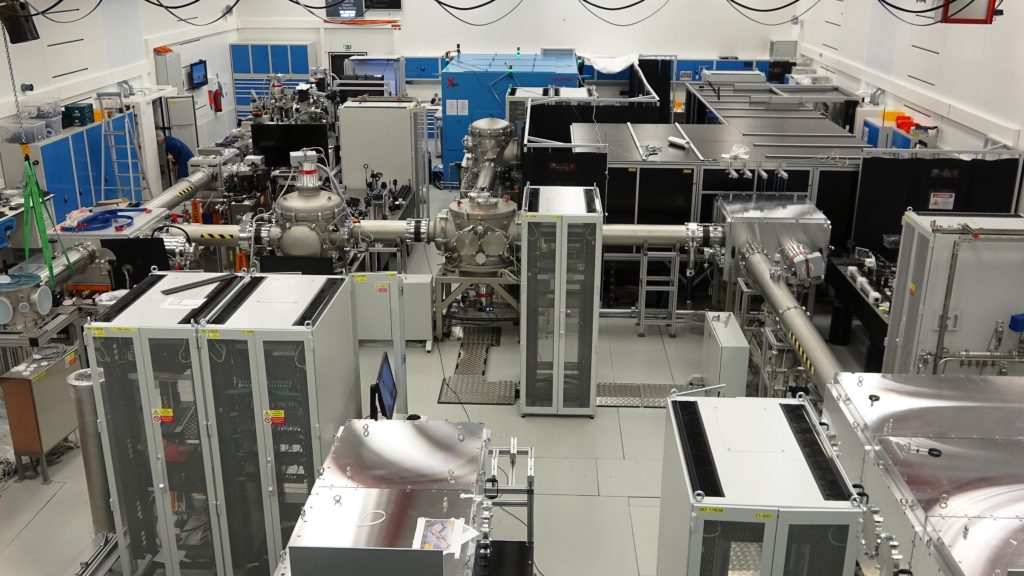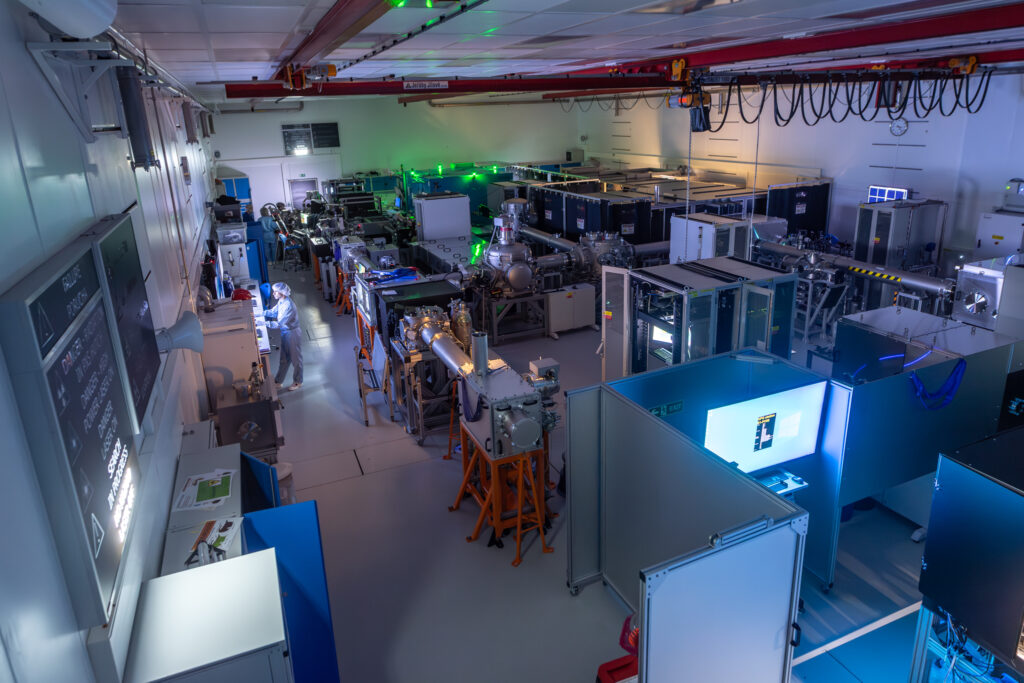This makes it possible to carry out demanding pump-probe experiments, with the particular aim at understanding the complex dynamics underpinning advanced functions or fundamental processes. Researchers will be able to study the mechanisms of physical, chemical and biological processes at the atomic level and on time scales ranging from femto- to milliseconds, study and control electronic processes and study complex systems in a range of environments. Central experimental technologies include time-resolved diffraction, scattering and imaging techniques, optical (IR to DUV), XUV and X-ray spectroscopy and sub-picosecond pulse radiolysis. Scientific instruments for user operations are:
- MAC: A multi-purpose end station for atomic, molecular, and optical (AMO) sciences and coherent diffractive imaging (CDI)
- ELIps: A materials science platform based on a time-resolved spectroscopic ellipsometry in the optical range and VUV magneto-optical ellipsometry
- TREX: A modular station for hard X-ray sciences covering applications in diffraction, spectroscopy, pulse radiolysis and imaging
- Advanced optical spectroscopy capabilities in the THz-to-UV range, including a setup for stimulated Raman scattering, transient optical absorption, IR (1D and 2D) and pulse-shaping and coherent control.

Already in 2018, the team provided more than 1 200 hours of experimental time together with external collaborators. In 2019 and 2020 we have published two open call for users to participate in user-assisted commissioning and early experiments resulting in the scheduling of about 40 experiment.
Together with our close collaborators in the ELIBIO team, the department for Structural Dynamics makes up a highly international team consisting of 15 nationalities working at the ELI Beamlines facility.
Jakob Andreasson: Department head (D88SD), jakob.andreasson@eli-beams.eu
Janos Hajdu: Team leader (ELIBIO), janos.hajdu@eli-beams.eu
Maria Krikunova: AMO science (also ELIBIO), maria.krikunova@eli-beams.eu
Eva Klimesova: AMO science, eva.klimesova@eli-beams.eu
Andreas Hult Roos: AMO science
Kushal Shaw: AMO science (to join)
Borislav Angelov: X-ray scattering and diffraction (also ELIBIO), boris.angelov@eli-beams.eu
Vitaly Polovinkin: X-ray scattering and diffraction (ELIBIO), Vitaly.Polovinkin@eli-beams.eu
Krishna Khakurel: X-ray scattering and diffraction (ELIBIO), KrishnaPrasad.Khakurel@eli-beams.eu
Anna Zymakova: X-ray spectroscopy, anna.zymakova@eli-beams.eu
Martin Precek: Pulse radiolysis, martin.precek@eli-beams.eu
Iuliia Baranova: X-ray diffraction/protein crystallography (PhD student with Charles University)
Shirly J. Espinoza: Soft X-ray material science and time-resolved ellipsometry (also ELIBIO) shirly.espinoza@eli-beams.eu
Martin Zahradnik: Soft X-ray material science and time-resolved ellipsometry, Martin.Zahradnik@eli-beams.eu
Miroslav Kloz: Ultrafast spectroscopy (also ELIBIO) miroslav.kloz@eli-beams.eu
Mateusz Rebarz: Ultrafast spectroscopy mateusz.rebarz@eli-beams.eu
Ziaul Hoque: Ultrafast spectroscopy and AMO science
Jakub Dostal: Ultrafast spectroscopy, jakub.dostal@eli-beams.eu
Nils Lenngren: Ultrafast spectroscopy, nils.lenngren@eli-beams.eu
Yingliang Liu: Ultrafast spectroscopy (ELIBIO), Liu@eli-beams.eu
Rachael Jack: ELIBIO Biolab manager (ELIBIO) rachael.jack@eli-beams.eu
Petra Cubakova: Biolab technician/PhD student in ultrafast spectroscopy (ELIBIO), Petra.Cubakova@eli-beams.eu
E1 experimental hall: What users get
Together with the Research programme for X-ray source development, the Department for Structural Dynamics runs experimental capabilities for user operations in the E1 experimental hall and its support laboratories. The following main instruments are expected to be available at the time for the next open call of user experiments (expected in early 2021).

- Variable gas target
- Variable focal length (2.5, 5 and 14 m)
- Time-preserving monochromator: Optics Express Vol. 19, Issue 20, pp. 19169-19181 (2011)
- Elipsoidal focusing optic: verified spot: 20×20 um
MAC: AMO science (gas phase targets) and coherent diffractive imaging
- Electron and ion Time of Flight spectrometers
- Velocity Map Imaging
- Set-up for Coherent Diffractive Imaging
- Molecular beams, cluster source, aerosol sample delivery
ELIps: Time resolved spectroscopic ellipsometry and VUV material science applications
- Time resolved spectroscopic ellipsometry in the NIR to UV range
- Wavelengths pump beam: 266 nm, 400 nm or 800 nm
- Spectral range probe: 350 nm – 700 nm (1.8 eV – 3.5 eV) based supercontinuum generation in CaF2 or similar
- Time range: 0-5 ns, time resolution< 100 fs
- Station for VUV material science applications
PXS beamline. Presently in commissioning
- Main energy range: ~3 to 30 keV
- Main emission line (Bi L1): 10.8 keV
- Monochromatized beamline with Montel optic
- Broadband beamline with polycapillary optic
X-ray diffraction (operational with sealed tube source)
- Diffractometer: STOE (Darmstadt)
- Main detector: Dectris, Eiger X 1M
- Sample cooling; Cryostream (Oxford), cryostat (ARS)
- Complementary conventional Cu sealed tube X-ray source (AXO Dresden)
X-ray spectroscopy (in commissioning with sealed tube source)
- von Hamos geometry (J. Szlachetko et al., Rev. Sci. Instrum. 83, 103105, 2012)
- Gratings for ~ 3 to 10 keV
- Main detector: Andor CCD camera (Eiger can also be used)
- Complementary conventional Mo sealed tube X-ray source (XOS)
Ultrafast optical spectroscopy
- fs Stimulated Raman Scattering
- Transient optical absorption
- Pulse shaping
- IR pump/IR probe spectroscopy





